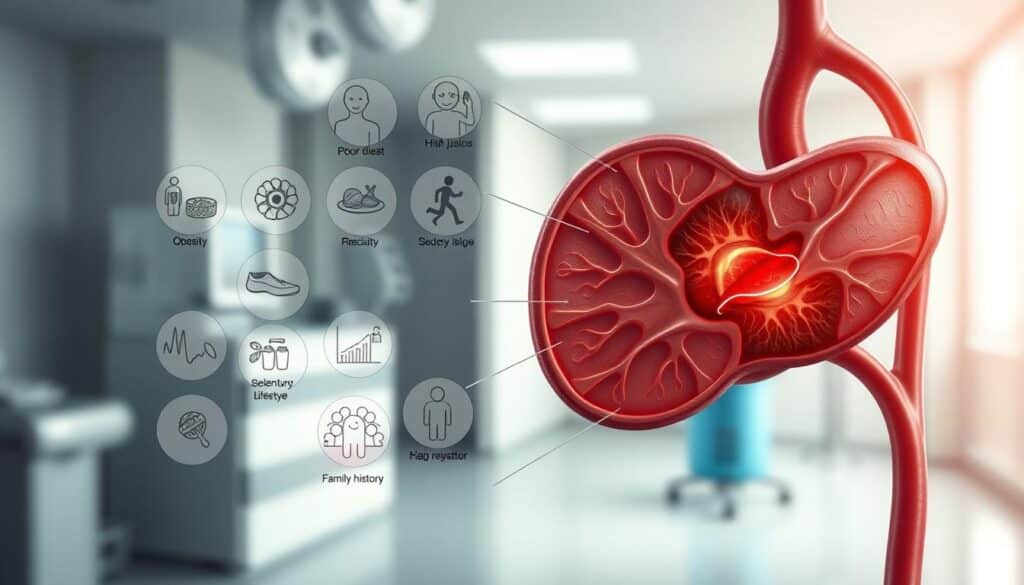Many people wonder about the relationship between sweeteners and metabolic health. While sugary items don’t directly trigger the condition, they create ripple effects that influence your body’s balance. Diabetes educator Sue Cotey, RN, emphasizes that frequent indulgence in high-calorie treats often leads to weight gain—a key factor in developing insulin resistance.
When you consume heavily processed snacks or sweetened beverages, your pancreas works overtime to produce insulin. Over time, this strain can reduce its efficiency. Studies show that diets rich in added sweeteners correlate with higher chances of developing metabolic disorders, even if genetics also play a role.
Not all sources are obvious. Hidden sweeteners lurk in everyday items like sauces, breads, and “healthy” snacks. Monitoring labels helps you spot these stealthy additives. This article will explore how both visible and concealed sources impact your well-being, backed by clinical research and expert insights.
Understanding this connection empowers you to make informed choices. We’ll break down how moderation, smarter substitutions, and awareness of nutritional pitfalls can help manage your long-term health risks.
Understanding Diabetes and Its Impact on Health
The body’s struggle with insulin lies at the heart of diabetes. This disease occurs when your pancreas can’t produce enough insulin or your cells resist its effects. Without proper insulin function, glucose builds up in your bloodstream instead of fueling your cells.
What Is Diabetes?
Diabetes is a chronic condition marked by elevated blood sugar levels. Symptoms like frequent urination, unexplained fatigue, and blurred vision signal that your body isn’t processing glucose effectively. While genetics play a role in some forms, lifestyle choices significantly influence Type 2 diabetes development.
Types of Diabetes and Their Causes
Type 1 diabetes is an autoimmune disease where the immune system attacks insulin-producing cells. It’s unrelated to diet or weight. In contrast, Type 2 diabetes often stems from poor dietary habits, excess weight, and inactivity, which strain insulin production over time.
Gestational diabetes occurs during pregnancy and usually resolves postpartum. Rare forms like Type 3c involve pancreatic damage from other conditions. Prioritizing vegetables, whole foods, and balanced intake helps manage risks, especially for Type 2.
Does eating too much sugar cause diabetes: Examining the Evidence
Research sheds light on how dietary choices influence metabolic pathways. While no single food directly causes diabetes, patterns of nutrition play a critical role in shaping your body’s response to glucose.

Sugar’s Role in Insulin Response
When you consume sweetened products, your pancreas releases insulin to manage blood glucose. Frequent spikes from soda or processed food force this system into overdrive. Over time, cells may resist insulin’s signals—a precursor to risk type diabetes.
Studies show these surges trigger inflammation and fat storage. One trial found adults with high added-sugar diets had 30% higher insulin resistance markers than those prioritizing whole food.
Research Linking Sugar Intake to Diabetes Risk
A global analysis of 175 countries revealed daily soda drinkers face 26% greater risk type diabetes. Hidden sweeteners in sauces, cereals, and “low-fat” snacks add up silently. For example, one flavored yogurt can contain more sugar than a candy bar.
Natural sugars in fruits act differently due to fiber slowing absorption. Nutritionists stress focusing on food labels and reducing processed items. Small swaps—like sparkling water instead of soda—help stabilize glucose without sacrificing flavor.
How Sugar Affects Your Body and Blood Sugar Levels
Your body processes different sugars in distinct ways that shape energy levels and long-term health. Understanding these mechanisms helps you recognize why food choices matter beyond just calorie counts.
Sugar Metabolism and Insulin Production
When you consume sucrose—common table sugar—it splits into glucose and fructose during digestion. Glucose enters your bloodstream, prompting the pancreas to release insulin. This hormone acts like a key, allowing cells to absorb glucose for energy.
Frequent consumption of processed sweets forces your pancreas to work harder. Over time, this strain can reduce insulin efficiency, raising risk type 2 diabetes. Research shows sustained high intake accelerates developing type diabetes by impairing cellular response to insulin.
Natural Sugars vs. Added Sugars
Fruits contain natural sugars paired with fiber, slowing absorption and preventing sudden blood sugar spikes. A banana’s fructose behaves differently than the refined sweeteners in soda. Added sugars flood your system rapidly, creating energy surges followed by crashes.
Processed snacks and sweetened drinks lack nutrients to balance their impact. This cycle of highs and lows stresses metabolic systems, increasing risk type 2 diabetes over decades. Choosing whole foods helps maintain steady energy while supporting insulin sensitivity.
Risk Factors and Lifestyle Influences on Diabetes
Understanding risk factors helps you navigate diabetes prevention strategies. While no single element guarantees developing type 2 diabetes, combinations of genetic traits and daily habits create pathways for metabolic disruption.

Weight Management and Insulin Sensitivity
Excess body fat, especially around the abdomen, releases inflammatory chemicals that interfere with insulin signaling. Over time, this resistance forces your pancreas to produce more insulin, straining its capacity. Studies show losing 5-7% of body weight improves glucose processing by 60% in high-risk individuals.
Heart disease shares this pathway—elevated blood sugar damages blood vessels while excess LDL cholesterol builds plaque. Both conditions thrive on poor dietary patterns and inactivity.
Genetic Clocks and Modifiable Choices
Your family history sets the stage, but lifestyle writes the script. Having a parent with type 2 diabetes increases your risk by 40%, yet physical activity cuts that likelihood in half. Age also plays a role, as muscle mass declines and fat storage shifts after 45.
Prioritizing fiber-rich meals and brisk walks counters genetic predispositions. Even small changes—like swapping sugary drinks for herbal tea—help stabilize glucose levels and reduce heart disease risks simultaneously.
Practical Tips to Reduce Sugar Intake and Lower Diabetes Risk
Simple adjustments to daily habits can significantly impact your health trajectory. Start by swapping sugary drinks for water infused with citrus or berries—this cuts empty calories while keeping hydration interesting. Research shows this single change lowers heart strain and stabilizes glucose levels within weeks.
Strategies for Cutting Back on Added Sugars
Check nutrition labels for hidden sweeteners like dextrose or malt syrup. These often appear in sauces, granola bars, and yogurt. Choose unsweetened versions and add natural flavor with cinnamon or vanilla extract instead.
Modify recipes by reducing sugar in baked goods by one-third. Most desserts taste equally satisfying with this adjustment. Balance fruits like berries or apples with protein-rich nuts to control energy crashes between meals.
Gradual changes create sustainable results. Replace one sugary snack daily with whole-food alternatives—think almond butter on celery instead of candy. Over time, these shifts protect pancreatic function and support heart health without drastic lifestyle overhauls.
Nutritional Strategies for a Balanced Diet
Smart food choices form the cornerstone of diabetes prevention. Prioritizing nutrient-rich whole foods over processed products helps stabilize glucose levels while reducing obesity risks. Start by filling half your plate with colorful vegetables—their fiber slows sugar absorption and keeps you fuller longer.
Whole Foods, Fruits, and Vegetables
Leafy greens, berries, and legumes deliver essential vitamins without spiking blood sugar. Their natural fibers act like buffers against rapid glucose surges. Research shows diets rich in these items lower added sugar cravings by 40% compared to processed meal plans.
Pairing fruits with proteins like nuts or Greek yogurt creates satisfying snacks. This balance prevents energy crashes and supports healthy weight management—a critical factor in fighting obesity.
Alternative Sweeteners and Moderation Techniques
Options like stevia or monk fruit provide sweetness with minimal calories. However, some products blend these with artificial additives. Always check labels for hidden added sugar in “sugar-free” items.
Try gradually reducing sweeteners in coffee or oatmeal. Your taste buds adapt within weeks. For baking, replace half the sugar with mashed banana or applesauce—ways to maintain flavor while cutting added sugar by 50%.
Plan meals around lean proteins and complex carbs like quinoa. These ways of eating keep blood sugar steady while addressing obesity concerns through mindful nutrition.
Conclusion
Managing your metabolic health requires understanding how daily choices shape long-term outcomes. While sweeteners don’t directly trigger diabetes, they fuel conditions like insulin resistance and weight gain—key drivers of diabetes risk. Research confirms that excessive sugar intake strains your pancreas and disrupts blood sugar regulation over time.
Prioritizing whole foods over processed snacks helps stabilize glucose levels naturally. Pairing fruits vegetables with lean proteins creates balanced meals that curb cravings and support healthy weight management. Regular physical activity further enhances your body’s ability to process sugars efficiently.
Start by auditing hidden sweeteners in sauces, dressings, and packaged goods. Small swaps—like opting for sparkling water instead of soda—reduce sugar intake without sacrificing flavor. Monitoring your blood sugar through routine check-ups provides early warnings of metabolic shifts.
Your path to lower risk developing diabetes begins with informed, consistent choices. Embrace nutrient-rich diets, stay active, and educate yourself on nutritional labels. Every step toward balance strengthens your defense against metabolic disorders.
FAQ
Can consuming sugary foods directly lead to diabetes?
While sugary foods don’t directly cause diabetes, excessive intake can contribute to weight gain and insulin resistance. Over time, these factors raise your risk of developing type 2 diabetes. Prioritizing whole foods like fruits, vegetables, and lean proteins helps maintain stable blood glucose levels.
Are natural sugars safer than added sugars for managing diabetes risk?
Natural sugars in whole fruits or dairy come with fiber, vitamins, and minerals that slow glucose absorption. Added sugars in sodas, snacks, and processed foods spike blood sugar faster and lack nutritional value. Limiting added sugars supports better metabolic health.
How does obesity influence the likelihood of developing diabetes?
Excess body fat, especially around the abdomen, increases insulin resistance. This forces the pancreas to work harder, which can lead to type 2 diabetes over time. Combining a balanced diet with regular physical activity helps manage weight and reduces this risk.
What are effective ways to reduce added sugar in daily meals?
Swap sugary drinks for water or herbal teas, choose unsweetened snacks like nuts or yogurt, and read nutrition labels to avoid hidden sugars. Cooking at home with fresh ingredients also gives you control over sugar content in meals.
Can genetics override lifestyle choices in diabetes prevention?
Genetics play a role in susceptibility, but lifestyle choices like diet and exercise significantly influence outcomes. Even with a family history, maintaining a healthy weight and minimizing processed sugars can delay or prevent type 2 diabetes.
Are artificial sweeteners a safe alternative for lowering diabetes risk?
Options like stevia or monk fruit provide sweetness without spiking blood glucose. However, moderation is key, as some studies suggest overuse may affect gut health. Focus on whole foods first, and use alternatives sparingly.


